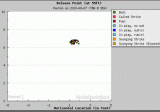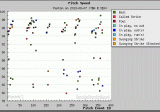I was hoping for six parts! Slacking! Lol
.
Q. How haaaaaard does this guy THROW?
A. To open the game, he leaned back, whipped the arm through, and -- 94 MPH. The rock and fire was as easy as soppin' country gravy with a buttermilk biscuit.
One pitch in ... Dr. D is thinkin' ... that delivery, that inertia on the ball, we been hearing 92-95 MPH and we been hearing wrong.
Paxton's first two pitches were 94 MPH.
Then he threw two fastballs at 95 MPH.
The three fastballs after that were 96 MPH.
The next two fastballs after that were 97 MPH, and the inning was over. Dr. D never noticed a Ray load up on a pitch again. (Longoria's HR, Paxton supplied the power in Big Unit fashion, and Longoria took a short swing, squared it super cleanly, and then flourished the finish.)
Here is some perspective:
| Occasion | Fastball avg MPH |
| James Paxton, 9.6.13 | 96.1 or 95.1* |
| Michael Pineda, 2011 |
94.7 |
| Stephen Strasburg, 2013 | 95.7 |
| David Price, 2013 (fastest LHP in MLB) | 93.7 |
| Clayton Kershaw, 2013 |
92.5 |
| Chris Sale, 2013 | 93.1 |
.
We'll leave it at that. We're not saying that Paxton is Randy Johnson. We're just saying, don't undersell Paxton's arm. That was TRULY ELITE left hand velocity out there.
If Paxton were able to sustain 96.1 MPH -- he definitely will not -- he would be the hardest thrower in a major league rotation, and the only LHP in the top ten.
*The 96.1 was off Brooks, available at the time of article; the 95.1 was off Fangraphs the next day. The other guys are off Fangraphs, so it's more apples-to-apples. In either case, the song remains the same.
.
Q. What's this about LHP velocity again?
A. About 30% of baseball pitchers are LHP, whereas only 15% of the population is lefty. Right handed human beings go through a finer-grain filter to play MLB(TM) -- so they have to throw harder.
MLB batters are used to 92 MPH from righties, 89-90 from lefties. You add 1-2 MPH to the effective velocity of a LHP, if comparing it to a RHP. Chris Sale throws 93, but that's as good as 95 from a righty.
Only David Price, Matt Moore, Chris Sale, the Rangers' two kids, and Jon Lester throw above 92.5 MPH in the majors. They're all surviving. Oh, Kershaw and Gio Gonzalez are at 92.5 MPH. There is no LHP over 92 MPH who isn't a star.
A lefty arm like that, you gotta work pretty blinkin' hard not to make $80M. Get with the program. You hear the scouts talk about lefty heat, right?
.
Q. And what was that about "hidden velocity"?
A. Some pitchers release the ball closer to home plate than others. K-Pax has a looooong stride and long arms. (So do Price and Kershaw).
Every 12" of stride equals 1.5 MPH (dividing 60 feet by 90 MPH). Many pitchers get that or more on their strides. Hisashi Iwakuma does, um, not. Felix and Doug Fister are excellent here. Erasmo Ramirez loses -2 MPH or so. Paxton undoubtedly gains +1 or +2.
The "roll credits" line being, James Paxton's fastball is -- if representative on Saturday night -- one of the five best in baseball. Could be THE best.
.
Q. How does Paxton get so many grounders? The other flamethrowers are flyball pitchers.
A. Finally! we get the F/X on this kid. Read it and weep: Paxton's fastball sinks 3-5 inches relative to David Price's.
Price's 93-95 fastball rises 8-9 inches compared to vacuum, and has risen as much as 10-11 inches. Paxton's fastball, on Saturday, rose only 5 inches.
........
In addition, Paxton's release point sometimes touches 7' off the ground, even after planting the front foot in stride. So the angle is downward. The result is the dreaded "heavy fastball," even at 97 MPH. From BrooksBaseball.net, here is the release point chart:

And here are the outs the Rays made off Paxton:
- 12 groundouts
- 1 fly out
- 3 strikeouts
That's despite pitching up in the zone all night! I dunno. What do you say, Gordon, about a guy throwing 96 letter high, and getting a 12:1 grounder ratio with it? It's like Kendrys Morales stealing 80 bases. Somebody else is better qualified to comment. Jim Carrey, maybe?
.
Q. Those are the facts. What does Dr. D's slimy but agile mind process on the fastball? Was the fastball really that tough to get around on?
A. Every bit that tough.
The Rays went to their pepper swings after the third hitter ... Delmon Young in particular (hitting cleanup!) absolutely refused to move his thighs or hips an inch, just decelerating the bat through the zone to try to chip the ball at an infielder (which he did).
Wil Myers took a few decent swings, with the hip leading. Evan Longoria's swing on the HR was short and compact, but clean and he kept his self-respect.
Everybody else? It was every blinkin' inch a Randy Johnson game, with the batters caking out long before the ball got anywhere near home plate. How many hard-hit balls to the warning track did you see?
Paxton had Michael Pineda velocity, and from the left side. And from an overhand angle.
.
Q. Maybe this was a one-game aberration?
A. Maybe, but that was the easiest velocity we've seen since Brandon Morrow. Paxton's velocity was simply effortless, and in his last inning he was hitting 99 MPH:
 .
.
.
Q. How was it possible for K-PAX to run a 4+ ERA in the PCL with a weapon of this magnitude?
A. Therein lies a tale...
NEXT